4年制理學士課程
4年制的理學士學生,要得到The Degree of Bachelor of Science,須符合以下條件:
- 修讀至少240 Credits並取得及格成績,當中至少96 Credits 是來自Major/Minor Curriculum的Science Courses,當中包括2個Science Foundation Courses (12 Credits),13個Disciplinary Courses (78 Credits) 及1個Capstone Course (6/12 Credits)。
- 在下列課程/要求得到及格成績:
- 共18 Credits的語文課程
- 6個Common Core課程
統計學是科學的一門分支,著重數據的收集,整理,分析,解釋以及陳述。透過數據的整理和分析,統計學能幫助我們解釋社會上的現象;透過將數據模組化,我們能對現象作出預測。現代社會對數據的重視與日俱增,學習統計對我們在各領域的決策分析都有莫大的幫助。
在理學士課程中,主修統計可以讓學生學到各種的統計概念,以及統計方法及分析工具的各種應用。這些統計課程能夠訓練學生的數學,分析及計算技巧,以符合將來面對數據作決策分析的工作。
主修Statistics的學生不能同時修讀Computing and Data Analytics,Decision Analytics及Risk Management。
Bachelor of Science – Major in Risk Management (BSc – RM) 風險管理學
風險管理是與統計息息相關的一門學科,透過辨識,監控及預測來管理風險,來確保企業的營運順利。在管理風險的過程中,不但需要分析數據及風險的能力,更需要各種統計模型來有效預測風險,因此需要不少統計知識。風險管理被廣泛用於保險,金融及商業管理上,為擁有廣泛應用的重要學科。
在理學士課程中,主修風險管理可讓學生認識這門專業學科所需運用的理論與技巧,當中包括風險管理過程及統計模型等。學生可於不同的核心及選選修課程中學到風險評估,風險管理及監控的理論,甚至更深入的,數據挖掘,隨機分析等技術,為成為風險分析師立下基礎。
主修Risk Management的學生不能同時修讀Computing and Data Analytics,Decision Analytics及Statistics。
以下列出2023-24年入學的同學須修讀的課程:
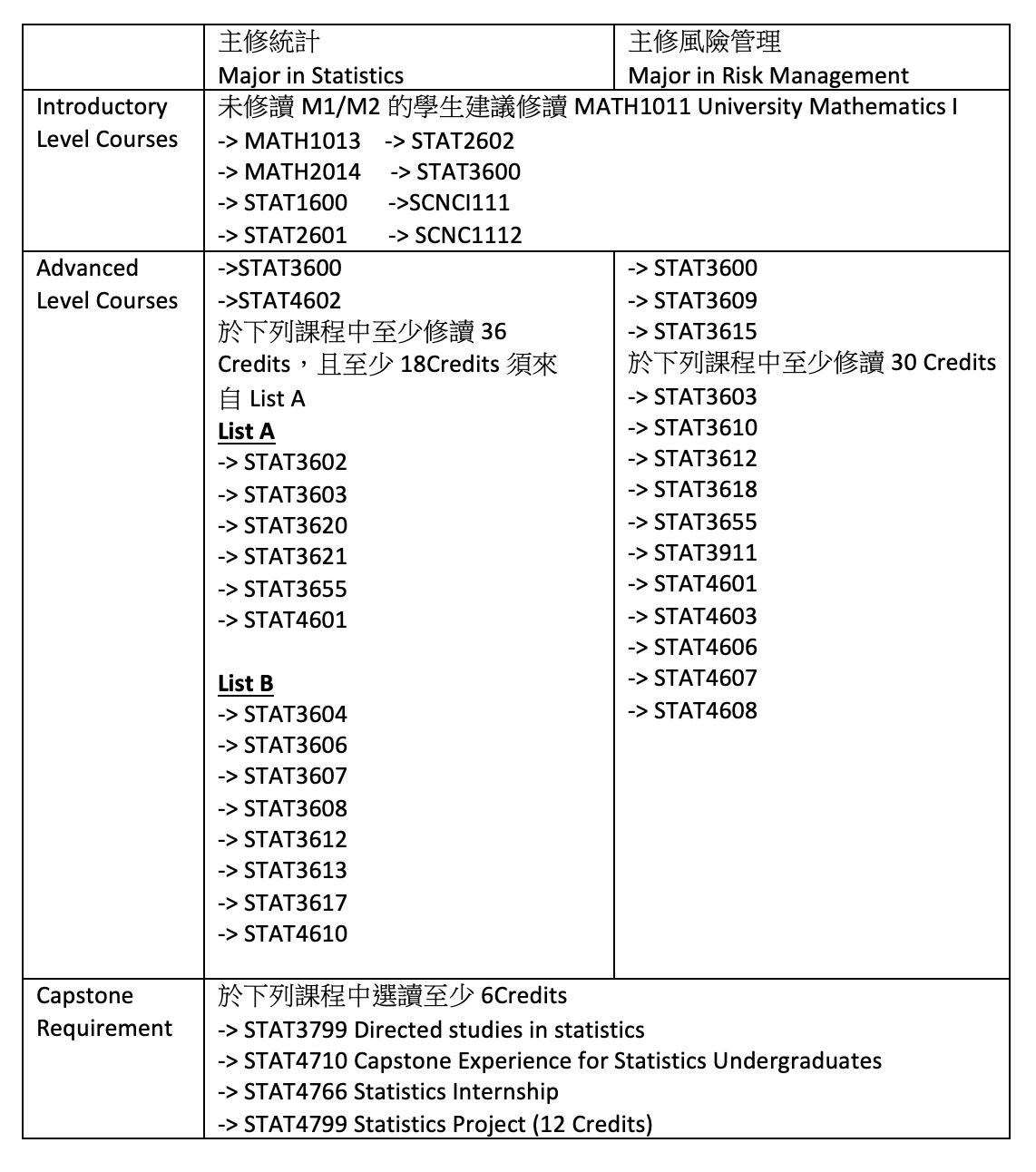
Bachelor of Science – Major in Decision Analytics (BSc – DA) 決策分析學
隨著現代科技的進步,更多不同數據資料能夠被記錄,儲存。人們手機傳送的一則訊息,瀏覽的一個網頁,都隨時被記錄作海量數據的一環。社會上這些日益增長的數據資料,被稱作“大數據”(Big Data)。面對大數據的時代,學會如何處理,分析,運用這些龐大數據已經成為社會上的新趨勢。決策分析就是結合電腦技術及統計分析方法,從大數據中找出關鍵資訊,以幫助重要決策的一門學科。決策分析應用廣泛,不論是科學,教育,商業及經濟方面都有其用處。
決策分析為理學士課程在2015-16學年新增的主修科目。課程特色是結合電腦技術,數學及統計分析技巧,讓學生學會分析數據及制定數據主導的策略。必修課程旨在讓學生學會決策分析的基本概念及方法,包括統計上的數據挖掘,數據分析;程式編寫,數據庫管理,及數學建模等;而選修課程則能讓學生選讀更專門的決策分析技術。整體來說,主修決策分析能夠讓學生掌握強大的分析及建模技巧,用於分析及詮釋不同領域上的大數據。
主修Decision Analytics的學生不能同時修讀Computing and Data Analytics,Applied Artificial Intelligence,Computer Science,Risk Management及Statistics。
以下列出2023-24年入學的同學須修讀的課程:
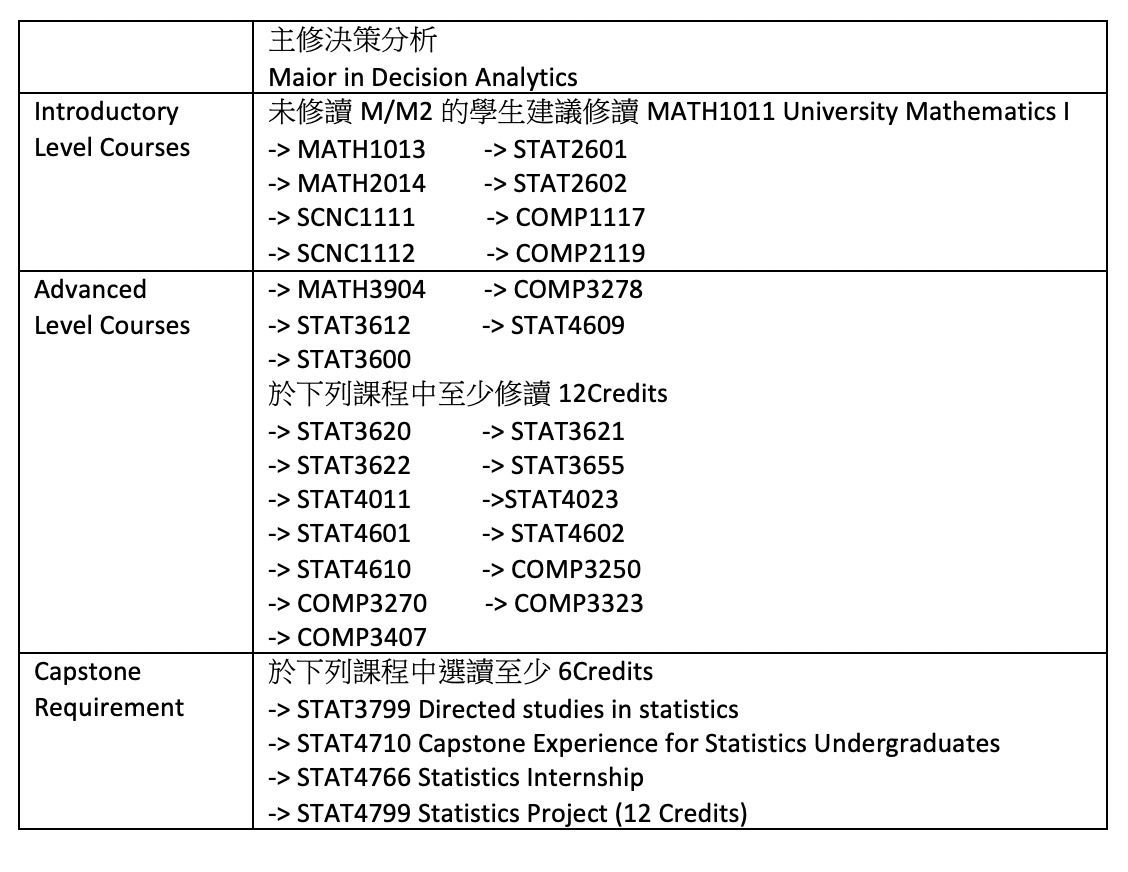
理學基礎課程:
理學士同學須於Year 1修讀兩個理學基礎課程,分別為SCNC1111 Scientific Method and Reasoning 及SCNC1112 Fundamentals of Modern Science。
如果同學於HKDSE數學科延伸單元一或二考試中取得第4級或以上的成績,或其他同等數學成績資格,則可申請豁免SCNC1111。
如果同學於HKDSE生物,化學及物理考試中取得第4級或以上的成績,或其他同等科目成績資格,則可申請豁免SCNC1112。
語文課程:
理學士同學須於Year 1-3修讀2-3個中文和英文課程,以滿足畢業要求。
理學院包括了三個英文課程 (CAES1000、CAES9820、CAES9821) 和一個課程 (CSCI9001)。
關於英文課程,修讀理學士的同學只需要在CAES9820和CAES9821選讀一個。CAES1000需要在Year 1完成 ; CAES9820或CAES9821需要在Year 2完成 ; 而CSCI9001需要在Year 3完成。
如果同學於HKDSE English取得Overall level 5成績,又或是於IELTS取得Overall 7.5、四卷分別不低於7的成績,可以豁免修讀CAES1000 (同學亦可以申請選擇修讀)。多出來的6個Credits可用作修讀Free Electives之用。然而,餘下兩個Language Courses則無法豁免。
Common Core:
Common Core 共分爲四個範疇(Area of Inquiry),分別是CCHU90XX – Humanities,CCGL90XX – Global Issues,CCCH90XX – China: Culture, State and Society,CCST90XX – Scientific and Technological Literacy。
理學士同學須於4年修讀6個Common Core課程,以滿足畢業要求。同學需在每個範疇均報讀最少1個、最多2個Common Core課程 ; 另外在同一學年內,同學不可報讀多於4個Courses ; 讀滿6個後亦不能再報讀任何Common Core課程;即在4個範疇中,同學修讀的Common Core數目為1, 1, 2, 2。可按此查看各個CC的詳情。
2nd Major/Minor
可按此查看Non-Science Discipline的2nd Major或 Minor
理學士同學需要注意的是有些Major及Minor不能同時修讀 (e.g. Major in Statistics and Minor in Risk Management),同時某些Non-Science Discipline的2nd Major或Minor會有附加條件。(e.g. 經濟及工商管理學院的計量金融學科要求同學達到特定GPA才能修讀該學院的課程及該學院的Major或Minor)。另外同學需要留意每個課程的Pre-requisites;在修讀某些Course前,會要求同學已經修讀前設的Course。詳情可以留意該課程的資料。除此以外,同學亦需要留意2nd Major/Minor有沒有和自己本身的Major有互斥(Mutually Exclusive) 的情況。例如STAT3618 Derivatives and Risk Management和經濟及工商管理學院的FINA2322 Derivatives屬於Mutually Exclusive的關係。同學需要留意學院的要求,而通常解決方法是需要另外修讀Electives,並同時通知學院。
Course Selection Adviser:
理學士同學提交Course Selection Report時,須讓一位Course Selection Adviser (CSA) (通常是來自該學生所Declare的Major) 簽署;在尋求Approval時,亦須諮詢CSA。

Course Load:
每年一般Course Load為60 Credits,但不能修讀多於72 Credits (Summer Semester的Courses不被計算在內)。如同學想修讀多於72 Credits,可以填寫表格,並交回辦公室。Year 1的同學不能修讀多於72 Credits。每學期同學可選擇修讀24至36 Credits。
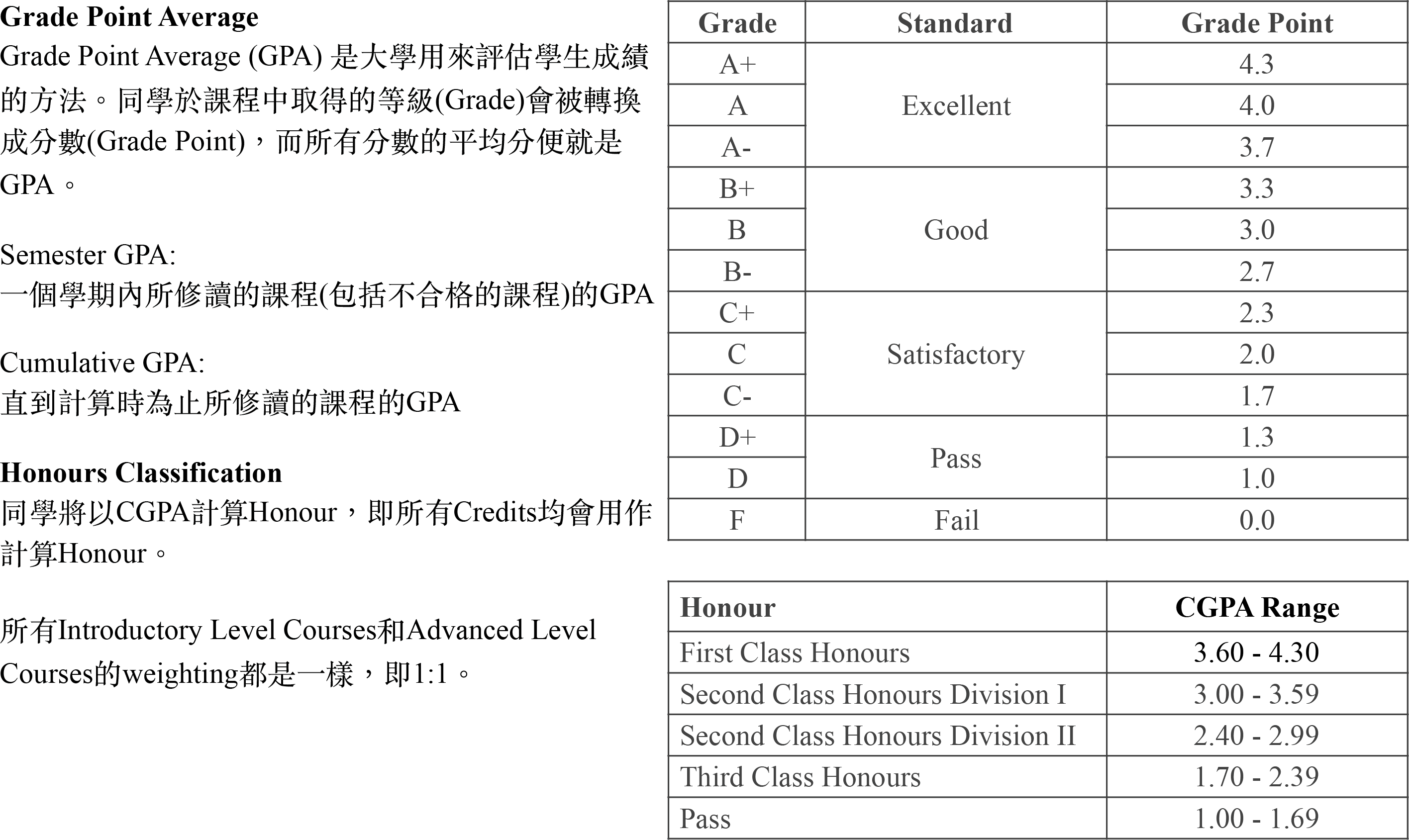
4年制精算學課程
Bachelor of Science in Actuarial Science – BSc (ActuarSc) 精算學
精算學課程旨在為希望加入精算專業的學生提供正式的學術和專業培訓。儘管精算學是一門獨立的學科,擁有自己的知識領域,但現代精算培訓需要概率、統計學、經濟學、投資、金融、法律、稅收和會計等多學科知識。精算學課程通過將各種跨學科課程納入基本精算培訓。該計劃旨在使學生具備紮實的精算學背景,培養他們的信心和分析能力,以定義和解決精算學和其他相關領域的問題。具體而言,精算學課程旨在為學生提供足夠的知識,以參加國際精算組織組織的早期專業考試,使他們能夠在畢業後順利投身精算行業。此外,精算學課程還為希望攻讀精算學或其他相關領域的研究生的學生提供足夠的學術培訓。
修讀精算學的學生可以任意修讀大學提供的Major及Minor,但同學需要確保能夠滿足修讀要求。
4年制的精算系學生,要得到The Degree of Bachelor of Science in Actuarial Science,須符合以下條件:
- 修讀至少240 Credits並取得及格成績,當中至少132 Credits是來自Actuarial Science Program的Courses,當中包括19個Disciplinary Core Courses (114 Credits),2個Disciplinary Electives Courses (12 Credits) 及1個Capstone Course (6 Credits)。
- 在下列課程/要求得到及格成績:
- 共2/3個語文課程 (18 Credits)
- 6個Common Core課程 (36 Credits)
以下列出2023-24年入學的同學須修讀的課程:
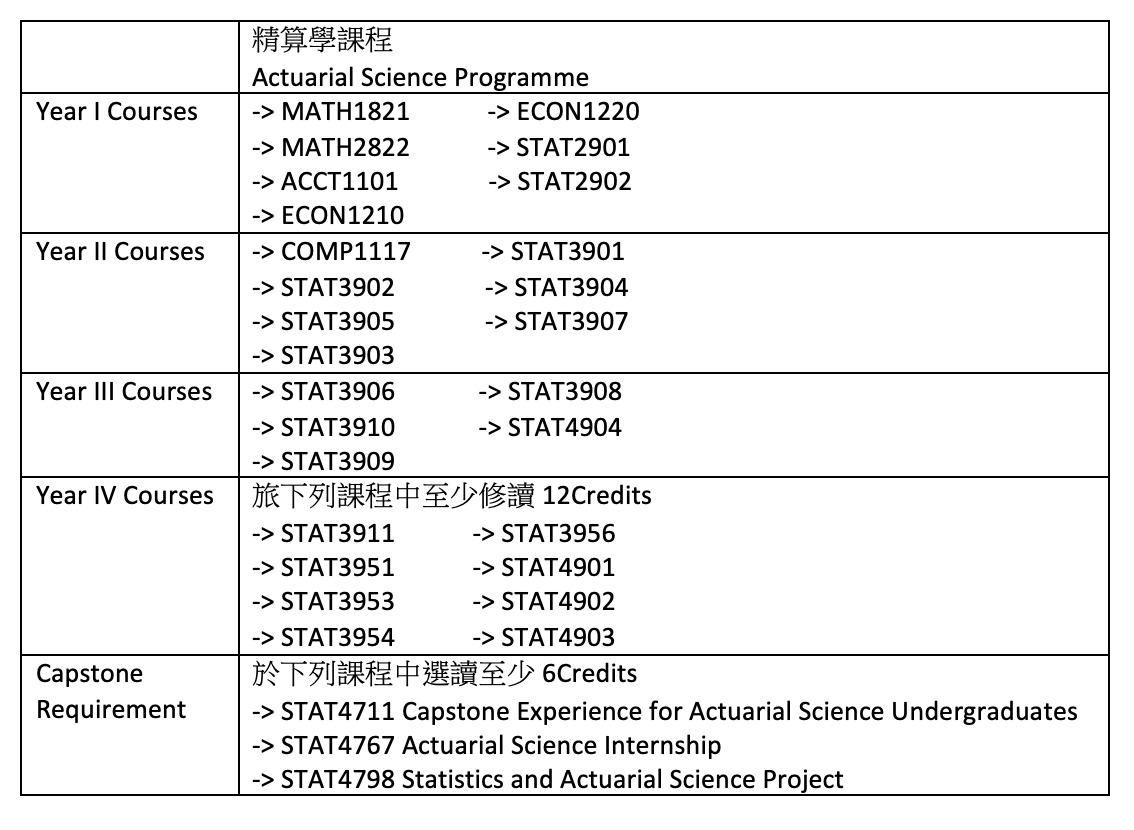
語文課程:
精算學同學須於Year 1-3修讀2-3個中文和英文課程,以滿足畢業要求。
理學院包括了三個英文課程 (CAES1000、CAES9820、CAES9821) 和一個課程 (CSCI9001)。
關於英文課程,精算學同學必須修讀CAES9821。CAES1000需要在Year 1完成 ; CAES9821需要在Year 2完成 ; 而CSCI9001需要在Year 3完成。
如果同學於HKDSE English取得Overall level 5成績,又或是於IELTS取得Overall 7.5、四卷分別不低於7的成績,可以豁免修讀CAES1000 (同學亦可以申請選擇修讀)。多出來的6個Credits可用作修讀Free Electives之用。然而,餘下兩個Language Courses則無法豁免。
Common Core:
Common Core 共分爲四個範疇(Area of Inquiry),分別是CCHU90XX – Humanities,CCGL90XX – Global Issues,CCCH90XX – China: Culture, State and Society,CCST90XX – Scientific and Technological Literacy。
精算學同學須於4年修讀6個Common Core課程,以滿足畢業要求。同學需在每個範疇均報讀最少1個、最多2個Common Core課程 ; 另外在同一學年內,同學不可報讀多於4個Courses ; 讀滿6個後亦不能再報讀任何Common Core課程;即在4個範疇中,同學修讀的Common Core數目為1, 1, 2, 2。可按此查看各個CC的詳情。
Course Load:
每年一般Course Load為60 Credits,但不能修讀多於72 Credits (Summer Semester的Courses不被計算在內)。如同學想修讀多於72 Credits,可以填寫表格,並交回辦公室。Year 1的同學不能修讀多於72 Credits。每學期同學可選擇修讀24至36 Credits。

4年制應用人工智能課程
Bachelor of Arts and Science in Applied Artificial Intelligence – BASc (AppliedAI) 應用人工智能學
隨著科技的進步,人工智能和機器學習成為世界的新趨勢。生活漸漸加入了人工智能的元素,以達到清晰,準確以及安全。人工智能在很多方面都已經成為不可或缺的一門,例如金融、城市規劃、醫療等。
在應用人工智能課程中,同學會學習到數學、統計和電腦的知識,同時參與各種交流,務求鼓勵同學用創新的方式將人工智能普及化,成為讓世界進步的一環。
4年制的應用人工智能系學生,要得到The Degree of Bachelor of Arts and Science in Applied Artificial Intelligence,須符合以下條件:
- 修讀至少240 Credits並取得及格成績,當中至少96 Credits 是來自Applied Artificial Intelligence的Courses,當中包括11個Disciplinary Core Courses (66 Credits),4個Disciplinary Electives Courses (24 Credits) 及1個Capstone Course (6 Credits)。
- 在下列課程/要求得到及格成績:
- 2個語文課程 (12 Credits)
- 3個BASc Core課程 (18 Credits)
- 4個Common Core課程 (24 Credits)
以下列出2023-24年入學的同學須修讀的課程:
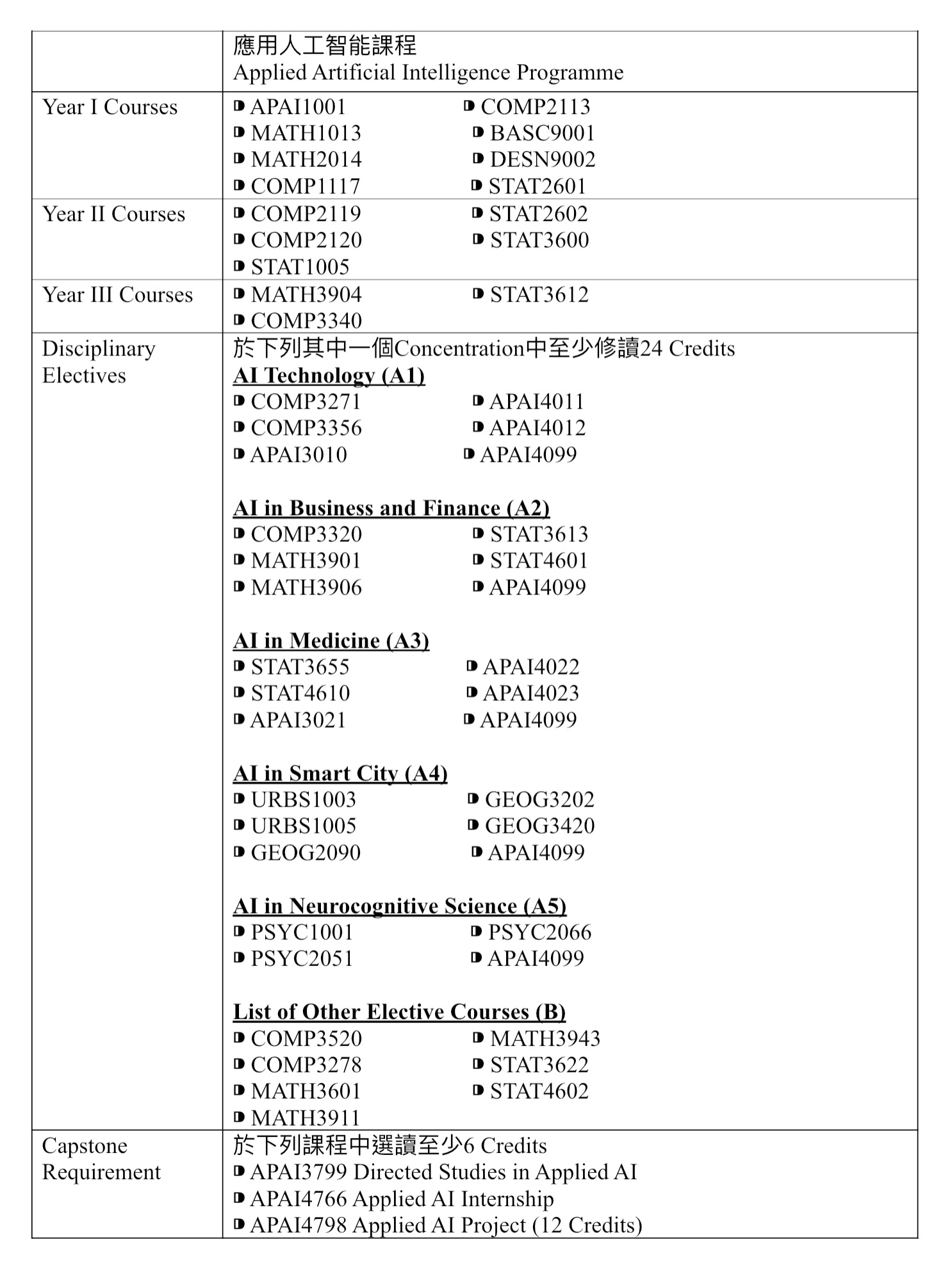
語文課程:
應用人工智能同學須於Year 1-3修讀2個中文和英文課程,以滿足畢業要求。
理學院包括了三個英文課程 (CAES1000、CAES9820、CAES9821) 和一個課程 (CSCI9001)。
關於英文課程,應用人工智能同學必須修讀CAES9821。CAES1000同學可以彈性選擇在Year 1完成 ; CAES9821需要在Year 2完成 ; 而CSCI9001需要在Year 3完成。
Common Core:
Common Core 共分爲四個範疇(Area of Inquiry),分別是CCHU90XX – Humanities,CCGL90XX – Global Issues,CCCH90XX – China: Culture, State and Society,CCST90XX – Scientific and Technological Literacy。
應用人工智能同學須於4年修讀4個Common Core課程,以滿足畢業要求。同學需在每個範疇均報讀最少1個Common Core課程 ; 另外在同一學年內,同學不可報讀多於4個Courses ; 讀滿4個後亦不能再報讀任何Common Core課程;即在4個範疇中,同學修讀的Common Core數目為1, 1, 1, 1。可按此查看各個CC的詳情。
Course Load:
每年一般Course Load為60 Credits,但不能修讀多於72 Credits (Summer Semester的Courses不被計算在內)。如同學想修讀多於72 Credits,可以填寫表格,並交回辦公室。Year 1的同學不能修讀多於72 Credits。每學期同學可選擇修讀24至36 Credits。

FRM考試
(資料來源:GARP FRM Candidate Guide)
目錄
| 基本信息 | 考試模式 |
| 考試日期及地點 | 報名考試及收費 |
| 獎學金 | 準備考試 |
FRM(Financial Risk Manager)為GARP(Global Association of Risk Professionals)設立的風險管理師專業資格,為金融風險領域內最受廣泛推崇及認證的專業資格之一。FRM考試集中測試考生對金融風險管理師工作技能及知識的認識,當中涉及風險模型、數理分析、信貸及市場風險管理等範疇。
報考FRM並沒有任何要求,但要獲得FRM的專業資格,考生必須先後通過兩部分的FRM考試,然後在於五年內達成最低兩年的工作經驗要求(於金融風險管理或相關領域)。
FRM考試一共有兩部分,分別涵蓋分析金融風險的工具,以及分析工具的深入應用。兩份考試的形式均為多項選擇題,合格分數由FRM委員會依每次考試決定。考試範圍及詳情如下:
Exam |
No. of Questions |
Time Allowed |
Topics Covered |
Weight |
Part I |
100 |
4 hours |
Foundations of Risk Management |
20% |
Quantitative Analysis |
20% |
|||
Financial markets and Products |
30% |
|||
Valuation and Risk models |
30% |
|||
Part II |
80 |
4 hours |
Market Risk Measurement and Management |
25% |
Credit Risk Measurement and Management |
25% |
|||
Operational and Integrated Risk Management |
25% |
|||
Risk Management and Investment Management |
15% |
|||
Current Issues in Financial markets |
10% |
GARP要求考生按順序完成兩個考試,即要先通過Part I的考試才可以報考Part II的考試。考生於通過Part I後,有四年的時間去通過Part II。考生也可以選擇在同一天內先後應考兩個考試,但要注意考生必須於Part I達到合格分數,否則Part II將不獲評分。
FRM Part I考試一年有三次,分別在五月,七月及十一月。FRM Part II 考試一年有兩次,分別在五月及十一月。Part I,II考試分別會在早上及下午進行,因此考生可選擇在同日報考兩個考試。香港的考試地點如下:Asia World – Expo Hong Kong International Airport Hall 3
除了在香港外,FRM在全球90多處地方都設有考場,考生可參考此網址尋找合適的考場。
要報名考試,同學可以到GARP的網站直接報名。每次的考試一共有兩個報名時段:Early, Standard;時段越早,收費便越便宜。第一次報考FRM的考生需注意,在報考Part I時需額外收取US$400的註冊費,以豁免之後報名時的額外註冊費。十一月及十二月考試的收費如下:
New Candidate - FRM Exam Part I
Registration Period |
Early |
Standard |
Exam Period |
Date |
30 April 2021 - 31 July 2021 |
1 August 2021 - 30 September 2021 |
13 November 2021 - 26 November 2021 |
Fee (Enrollment Fee +Exam Fee) |
US $950 |
US $1150 |
- |
Returning Candidate - FRM Exam Part I/II
Registration Period |
Early |
Standard |
Exam Period |
Date |
30 April 2021 - 31 July 2021 |
1 August 2021 - 30 September 2021 |
4 December 2021 - 10 December 2021 |
Fee (Exam Fee Only) |
US $550 |
US $750 |
- |
關於付款的詳情可以參考GARP的網站。考生需注意必須在報名時段結束前完成付款手續,否則將會被收取額外附加費。
需要文件
應考時,考生須攜帶准考證以及附有個人相片的護照或駕照作身份確認的用途。護照或駕照上的名字必須與考生註冊時填寫的吻合。GARP不接受其他如工作證,學生證等文件作身份確認。
計算機
考生僅可攜帶GARP所認可的計算機到考場。所有受認可的計算機如下:
- Texas Instruments BA II Plus (both versions), BA II Plus Professional
- Hewlett Packard 10 B II, 10B II+, 20B
- Hewlett Packard 12C
更改/取消預約
考試費用是不能退還的,但是考生可以選擇延遲考試至下一次考試日期(5月 --> 11月或11月 --> 5月)。但是要注意更改考試日期的申請必須在是次考試報名截止前,並需繳交US $100 的行政費。
另外,考生也可以選擇更改考試場地,僅需要到自己的GARP賬戶裡更改即可。
考試成績
考試成績將於考試後約六個星期內電郵予考生。
更多關於考試的資料及注意事項,同學可於GARP網站上了解更多。按此進入網站。同學也可以參考GARP FRM Candidate Guide 獲得更多詳情。
PRM考試
(資料來源:PRMIA PRM Exam Guide)
目錄
| 基本信息 | 報考要求 |
| 考試模式 | 報名考試 |
| 考試日期 | 考試費用 |
| 其他資訊 |
PRM(Professional Risk Manage)為PRMIA(Professional Risk Managers' International Association)設立的風險管理師專業資格,為行內與FRM(Financial Risk Manager)齊名的資格考試。PRM考試集中在工作技能的訓練,涉及銀行信貸、數理分析對監管的重要性。
要報考PRM考試,考生必須符合以下條件:
- 考生必須成為PRMIA的會員。(報名詳情可按此)
- 另外,在2014年後報考第一份考試的考生,必須達到最低的工作經驗要求:
1) 如考生不持任何學士學位: 4年
2) 如考生持有學士學位: 2年
3) 如考生為研究院畢業生或持有其他受認可的專業資格(CFA, CAIA, CQF等): 無工作經驗要求
並需於通過四個考試後向PRMIA提交文件證明。
要考獲PRM資格,考生須於兩個專業考試中獲得合格成績。考生可選擇一次過完成兩個單元,或於兩年內分別完成兩個考試(當中沒有順序要求)。
以下為各個考試的資料:
2022 Exam |
Exam Name |
No. of Questions |
Time Allowed |
I |
Finance Theory, Financial Instruments, Financial Markets and Mathematical Foundations of Risk Measurement |
60 |
4 hours |
II |
Risk Management Frameworks and Operational Risk, Credit Risk and Counterparty Credit Risk, Market Risk, Asset Liability Management, and Funds Transfer Pricing Case Study Practicum and PRMIA Standards and Governance (and a practicum portion that includes four scenarios in Exam I) |
84 |
4 hours |
考試形式為多項選擇題,題目會在題庫中根據考試範圍及比重隨機抽取,而每份考試的合格分數均為60%。關於每份試卷的詳細範圍及題目比重請詳閱PRMIA PRM Candidate Guidebook。
要報名考試,考生可於PRMIA的網站上購買Exam Voucher Bundle (包括四個考試的Exam Voucher及PRM Handbook),再利用PRMIA給予的Voucher Code,於Pearson VUE上選擇考試日期、時間和試場。
考生需注意不能在60天內重考某一考試,否則第二次考試的分數將不會獲考慮。另外,Exam Voucher在購買後30-36月將會失效,考生屆時需購買新Voucher以報考考試。
PRM考試采用固定的考試周期,考生可於周期內任何一天安排考試。周期一般為三週,並於2-3月;5-6月;8-9月;11-12月開放。目前的考試周期詳情如下:
Sheduling Window |
Testing Window |
1 January 2021- 30 June 2021 |
15 February 2021 - 30 June 2021 |
1 July 2021 - 10 September 2021 |
16 August 2021 - 10 September 2021 |
Special Testing Window for the PRM Exam 2 - Risk Management Practices |
|
19 August 2021 - 8 October 2021 |
20 September 2021 - 8 October 2021 |
11 September 2021 - 17 December 2021 |
15 November 2021 - 17 December 2021 |
1 January 2022 - 11 March 2022 |
14 February 2022 - 11 March 2022 |
18 June 2022 - 9 September 2022 |
23 May 2022 - 17 June 2022 |
10 September 2022 - 16 December 2022 |
15 August 2022 - 9 September 2022 |
1 January 2023 - 10 March 2023 |
13 February 2023 - 10 March 2023 |
11 March 2023 - 16 June 2023 |
22 May 2023 - 16 June 2023 |
17 June 2023 - 8 September 2023 |
14 August 2023 - 8 September 2023 |
9 September 2023 - 15 December 2023 |
13 November 2023 - 15 December 2023 |
報名考試後,考生可於Scheduling Window 的日期內於Pearson VUE上安排相應的考試日期。
Membership Type |
Application Fee |
Program Fee |
Risk Leader/Sustaining Member |
US$150 |
US$1080 |
Contributing Membe |
US$150 |
US$1180 |
Affiliate/Non Member |
US$150 |
US$1280 |
需要文件
應考時,考生須攜帶兩個有效身份證明文件,而其中一個必須是附有個人相片及簽名的由政府發出的有效身份證明文件。 (由政府發出的有效身份證明文件:身份證、護照等;另一有效身份證明文件:工作證件、信用卡等)
計算機
試場內電腦會提供一個科學計算機程式 - Texas Instrument TI-30XS,而考生不得攜帶包括計算機內的任何物品進考場。TI-30XS的使用指南於此,考生也可購買手提版的TI-30XS予自已熟悉操作。
更改/取消預約
考試費用是不能退還的。考生可在考試日期前一個工作日,於Pearson VUE上更改預約,否則將不能取消預約。
考試成績
考生可於考試後15個工作天後在PRMIA的網站上取得考試成績。
考試豁免
如考生持有CFA(Chartered Financial Analyst)或Associate PRM的專業資格,便可申請部份考試豁免,詳情如下:
Program |
Awarding Organization |
PRM Exemption |
CFA |
Charted Financial Analyst - CFA Institutue |
Exam I |
考生可連同証明文件寄電郵至 examexemptions@prmia.org作申請,豁免過程將收取US$25的費用。考生同時亦需注意豁免部分考試後,仍需付費全額報名剩下考試(即需購買PRM Exam Voucher Bundle)。
更多關於考試的資料及注意事項,同學可於PRMIA網站上了解更多。按此進入網站。
SOA
要成為一個合資格的精算師,首先要通過一系列的考試。在香港,大部分畢業生會應考由北美精算師協會 (Society of Actuaries,又稱SOA) 舉辦的專業試,以成為副精算師 (Associate of Society of Actuaries,又稱ASA),繼而取得精算師資格 (Fellow of Society of Actuaries,又稱FSA) 。
精算學同學可以在大學期間完成Exam P, Exam FM, Exam FAM, Exam ALTAM或Exam ASTAM, Exam SRM, Exam PA, Exam ATPA中幾門或全部的考試及達到VEE的要求。
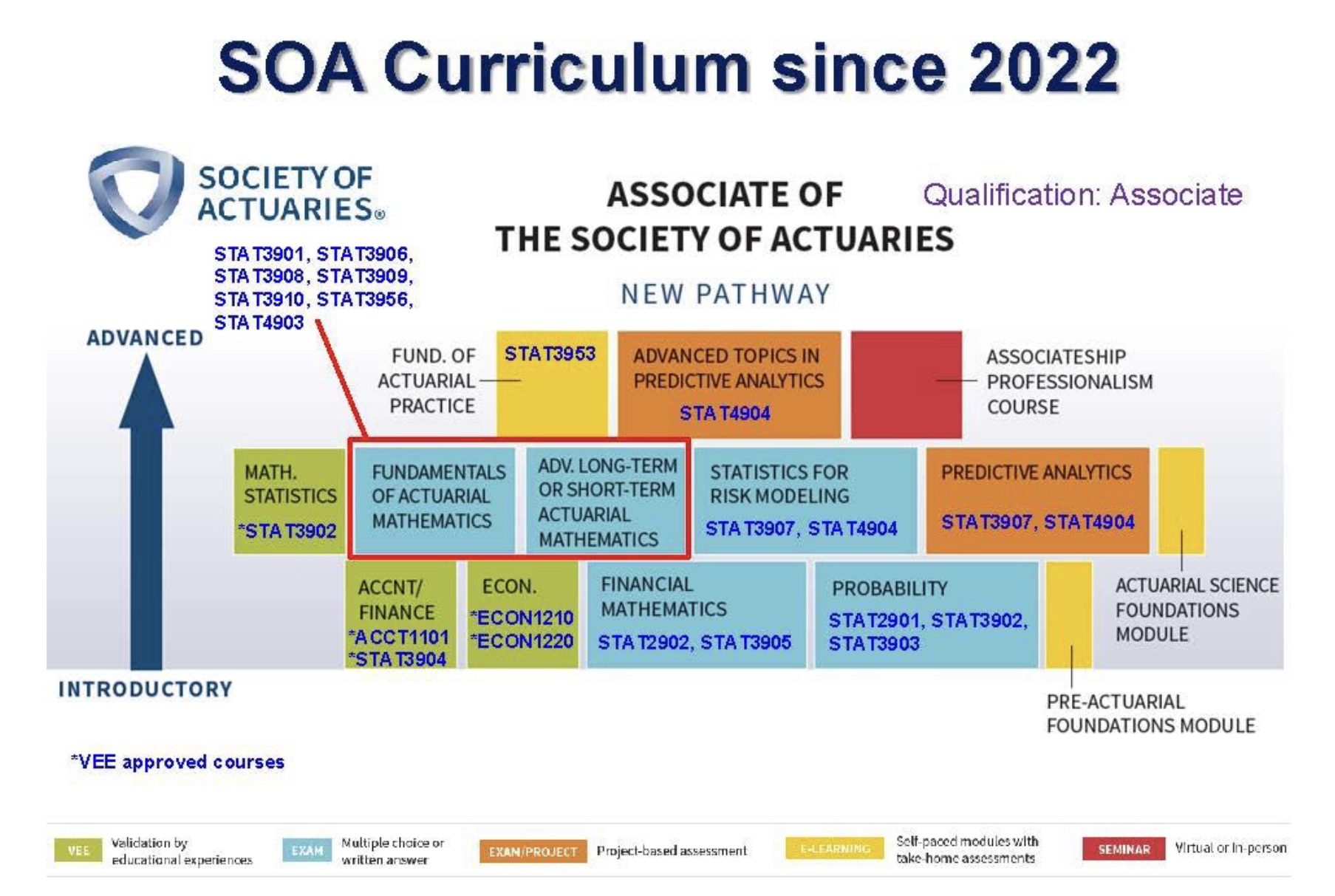
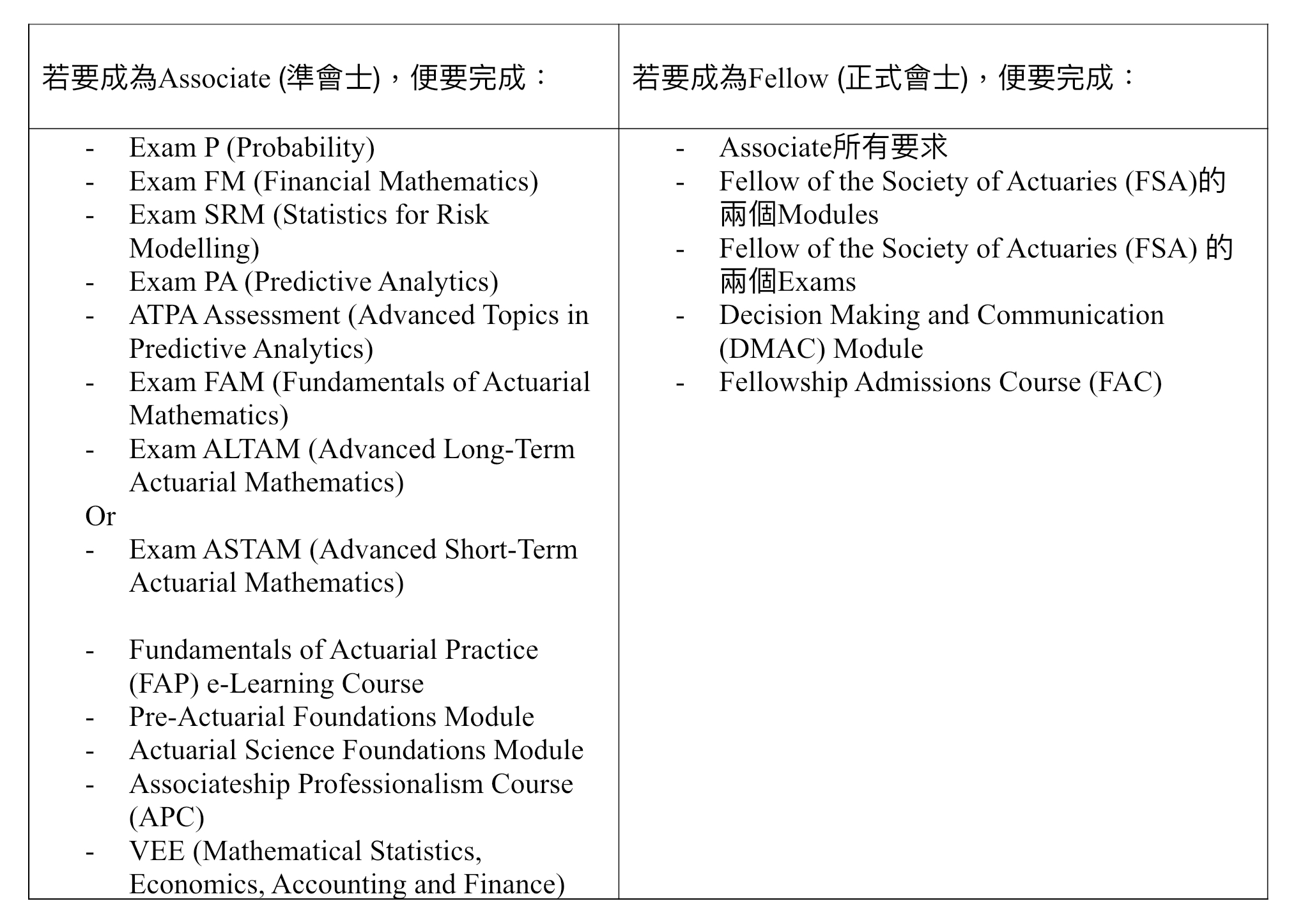
(更多資料:ASA Requirements,FSA Requirements)
考試申請:
同學可以在此進行網上報名。
請留意:同學如果擔心考試未能及格,可選擇先報考下一次的考試,然後等待考試的成績公布,若順利及格,報考下一次考試的費用將會自動全數退還。
請留意:考試報名應提前,否則容易遇到沒有考位的情況。一般建議考試日期前2個月之前報名。時間上,因為SOA網站上面只能給出考試時間段,建議先前往Prometric官網查看可能的考位情況,再決定報名。
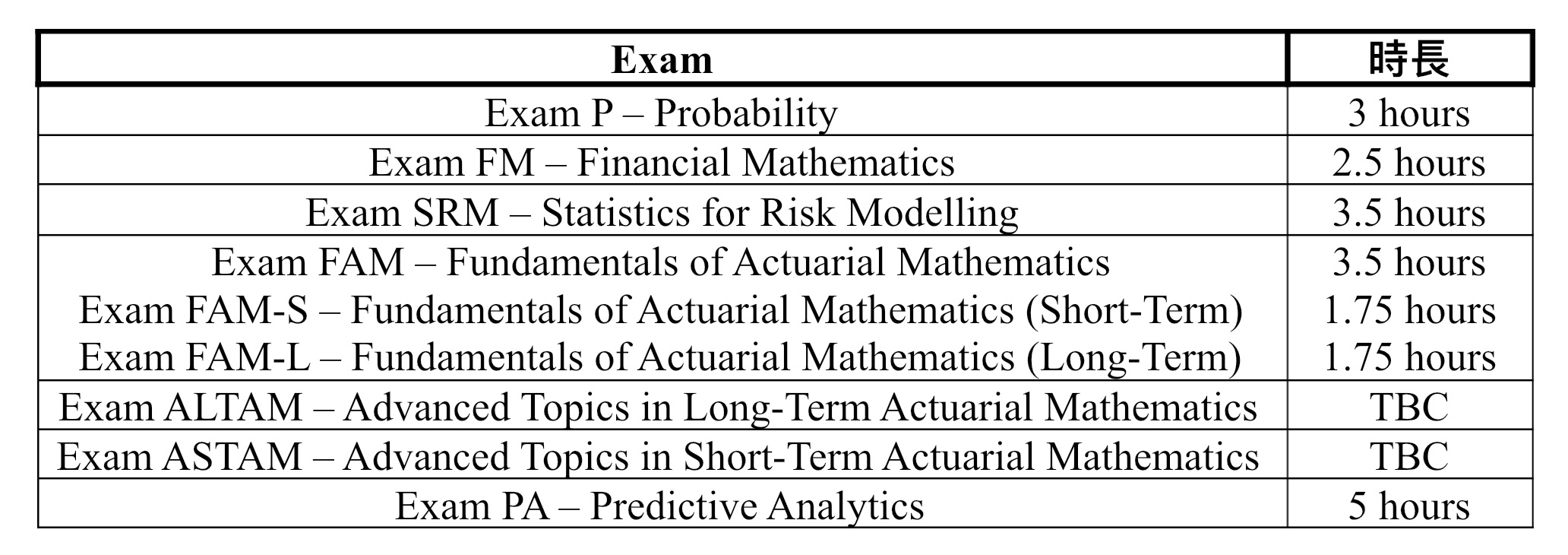

Exam FM, Financial Mathematics:

Exam SRM, Statistics for Risk Modelling:

Exam FAM / FAM(L) / FAM(S), Fundamentals of Actuarial Mathematics:

Exam PA, Predictive Analytics:

Exam GIINT, Introduction to General Insurance:

*Registration closes at midnight U.S. Central Time
*Limited/Selected sites
* Exams P, FM, MFE, MLC, C are identical to the CAS Exams 1, 2, 3F, LC, and 4 respectively.
(更多資料:Be An Actuary)
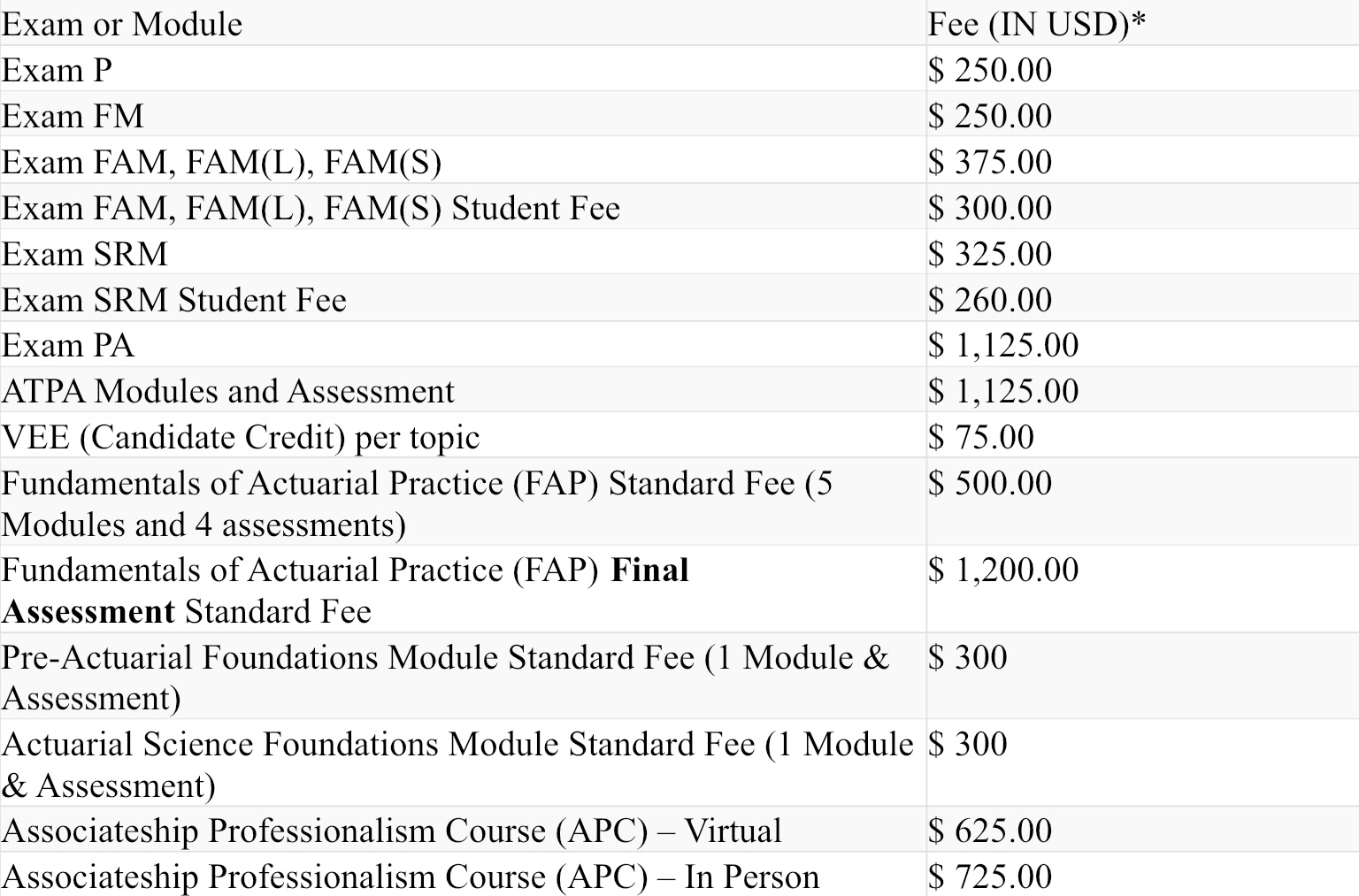
* Student Fee只適用於就讀全日制大學課程的考生。
(更多資料:2020 Examination Fees)
1. 退還考試款項
所有考試款項均不接受退還申請。
(更多資料:Refunds)
2. 更改/取消CBT預約
同學可於較早前預約考試的日期前兩個工作日(包括星期六)的中午之前,更改/取消預約(例如:同學較早前已預約了星期二考試,如果想更改/取消預約,考生須於星期五的中午前通知試場)。
同學如想更改/取消預約,便須於較早前預約考試的日期前兩個工作日的中午之前,完成下列其中一項:
a. 於www.prometric.com/SOA更改/取消預約 ;或
b. 通知試場(同學必須告知試場的管理人,不能在電話留言信箱裏留言)
(更多資料:BeAnActuary.org)
3. Ticket of Admission
當申請考試後,SOA會自動電郵Acknowledgement Letter給各位考生作為Ticket of Admission,並附有考生編號及試場編號。有關CBT Exam P & FM,考生編號並未即時被啟動。當考生編號被啟動時,SOA將會電郵Letter of Confirmation,講解安排考試時間的程序,並按Letter of Confirmation的指示,到www.prometric.com/soa/登記考試日期及時間。
如果Acknowledgement Letter / Ticket of Admission上有錯誤,請盡快聯絡 customerService@soa.org。如果同學十日內未收到Acknowledgement Letter / Ticket of Admission,可以聯絡 CustomerService@soa.org。
4. 需要文件
應考Exam P & FM之外的考試時,考生須攜帶有效的Ticket of Admission (Mailed hard copy or Printed e-mail version)及附有個人相片及簽名的有效身份證明文件。
應考Exam P & FM時,考生須攜帶附有個人相片及簽名的有效身份證明文件。如果同學在自己所屬國家而自己所屬國家的身份證明文件缺少個人相片或簽名(但不是同時缺少該兩項),同學須同時攜帶由政府發出的有效身份證明文件及一張額外有效身份連簽名的證明文件(例如:工作證件,學生證件,信用卡等)。
各位同學須在試場簽署。如果同學未能提供有效身份證明文件,或拒絕/不能提供與有效身份證明文件的簽署,將不能進入試場。
(更多資料:BeAnActuary.org)
5. 計算機
考生只能使用Texas Instruments的計算機,型號分別為:
o BA-35,
o BA II Plus,
o BA II Plus Professional,
o TI-30Xa,
o TI-30X II (IIS solar or IIB battery)
o TI-30X MultiView (XS Solar or XB Battery)
考生能夠攜帶多於一部計算機。如果同學使用其他上述沒有提及的計算機,便將取消考試資格。
考生不得攜帶計算機的說明書。考試期間,計算機的外殼須要移除,讓監考人員證明該計算機是准許的。同學使用其他的計算機,便將取消考試資格,即其考試將不給予成績級別。
TI-30X II (IIS solar or IIB battery) 及 TI-30X MultiView (XS Solar or XB Battery) 的儲存記憶將於考試前由監考人員清除。BA II Plus 及 BA II Plus Professional 的設定將回復至出廠時的設定。
6. CBT Tutorial
網上提供了一個CBT tutorial,展示CBT的畫面及示範CBT如何運作,讓報名參加CBT Exams的考生熟習。所有的上機操作應參考這個tutorial
7. 考試成績
考試後,同學將收到個別通知,告知考試成績的等級分數,時間需時若完成考試後八至十個禮拜。另外,SOA亦會於網上公布及格考生的名單。
成績等級分為0至10。及格等級為6至10;不及格等級為0至5。等級間距為需要及格的等級分數的10%,例如:等級分數5代表己得到需要及格的等級分數的最少90%,但不能得到需要及格的等級分數的100%;等級分數8代表己得到需要及格的等級分數的最少120%,但不能得到需要及格的等級分數的130%;等級分數0代表得到少於需要及格的等級分數的50%,並非代表該試卷中得不到任何分數。
除了EA-1 或 EA-2考試外,試卷將不發還給考生。
(更多資料:Examination Results)
8. 覆核試卷
如果考生認為Paper/Pencil的Multiple-choice試卷批改時有錯誤,同學可以於成績公布後的60日內向SOA提出申請人手批改覆核試卷。每次覆核將收取US$50 (Credit card (MasterCard, Visa, American Express), Certified Check or Money Order)。同學請不要提出申請覆核試卷直到成績公布。如有問題,請聯絡 handscoring@soa.org。
(更多資料:Hand scoring of Exams)
VEE
(資料來源:VEE–Validation by Educational Experience)
若精算學同學挑選SOA考取精算師資格,除了要應付SOA的各個考試外,還要符合VEE的要求。VEE為Validation by Educational Experience,是一個考試以外的要求,用作認證同學在其他範疇的知識。一般同學都會選擇修讀經VEE認可的大學課程。同學只需在該課程得到B-或以上的成績,即可完成對應的VEE要求。當前VEE有三個科目:
VEE* Mathematical Statistics
VEE* Economics
VEE* Accounting and Finance
同學須完成Microeconomics Component和Macroeconomics Component才能符合整個VEE Economics的要求。
同學須完成Accounting Component和Finance Component才能符合整個VEE Accounting and Finance的要求。
完成VEE的方法有下列三種:
1) 大學課程
完成VEE認可的大學課程,並需要取得B-或以上。以下列出了VEE認可的港大課程:
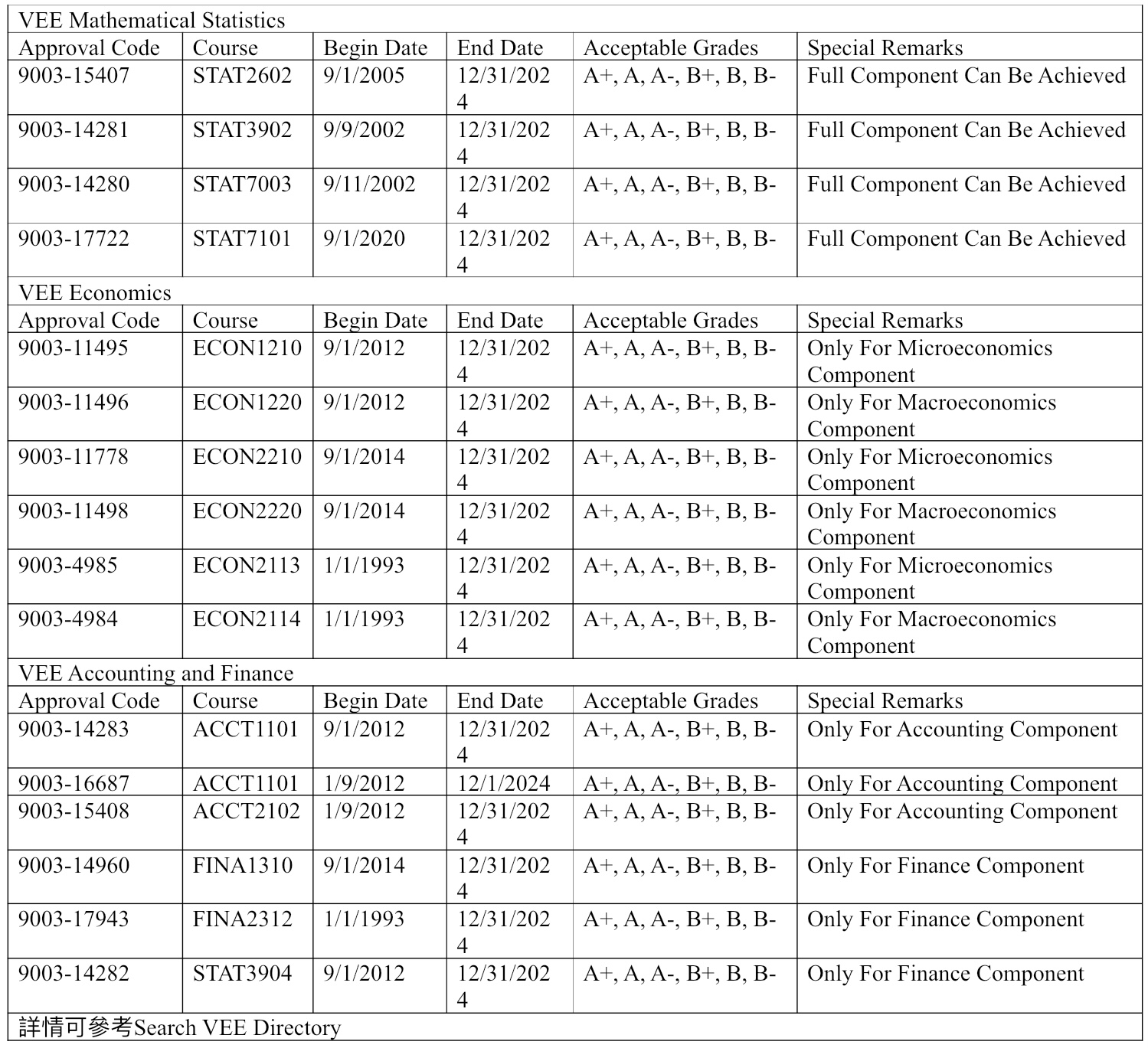
注意精算同學不能修讀STAT2602,應該以STAT3902滿足VEE Mathematical Statistics。
注意精算同學不能修讀FINA1310,應該以STAT3904滿足VEE Finance Component。
2) 合資格及認可的其他途徑:
除了港大的課程之外,尚有以下的機構提供不同種類的課程。同學們可以參考一下網站https://store.soa.org/VEESchoolSearch.aspx?VEE=displayonly&VEEOnly=Y
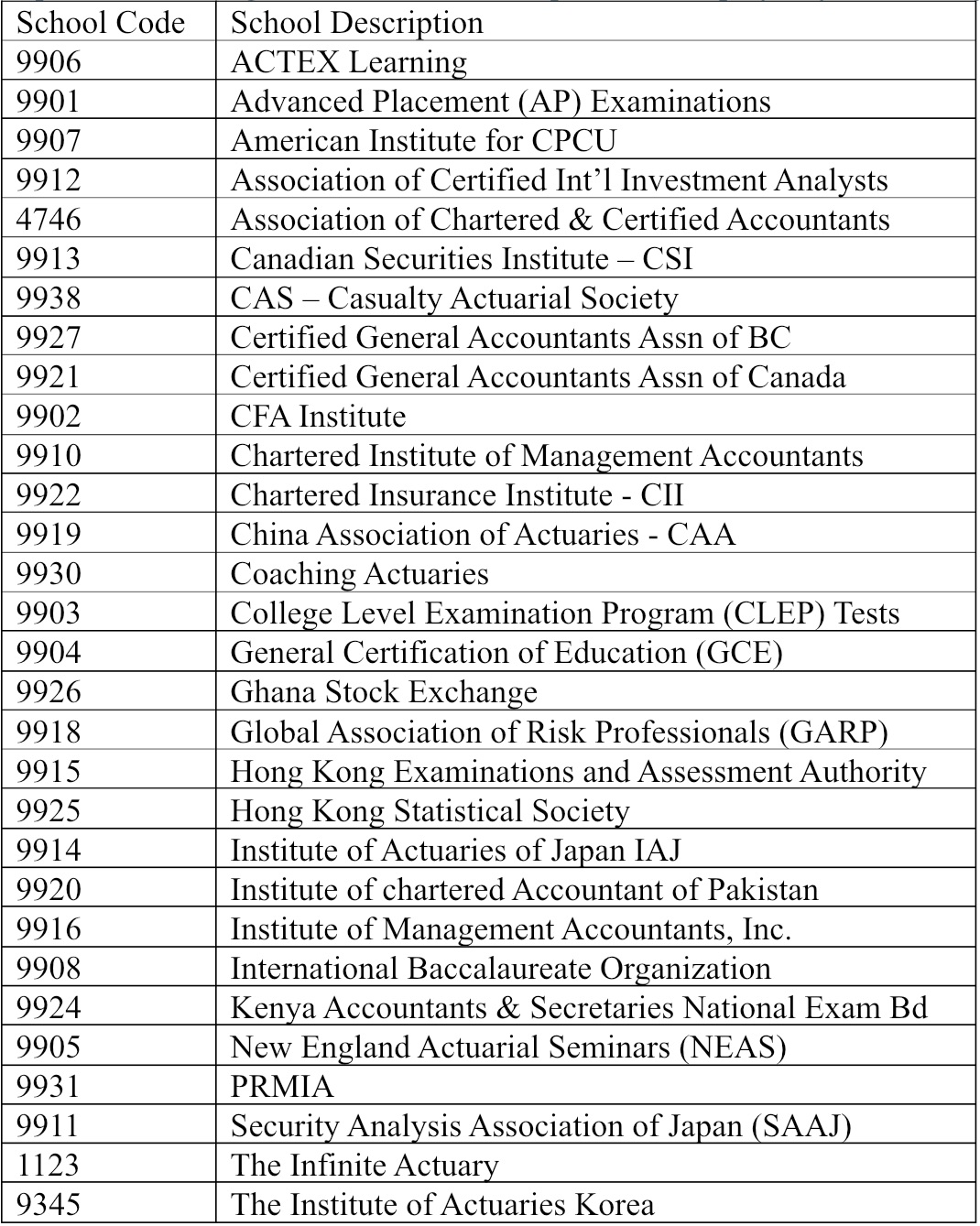
3) VEE Credit申請方法:
同學若希望申請VEE Credit,必須在至少兩個SOA/CAS的精算試取得Credit,才能申請VEE Credit。除了遞交申請表格外,同學還須提供Official Transcript證明曾修讀相關VEE課程。只有經VEE認可的課程或其他途經才能用作為VEE Credit。
考生不得申請部分VEE Credit (例如不能夠只選擇申請Microeconomics Component而不選擇申請Macroeconomics Component)。另外,考生不得只申請某課題的VEE Credit,直到完成所有要求。
- US$50 - 1個VEE課題
- US$75 - 2個VEE課題
- US$100 - 3個VEE課題
VEE–ACCOUNTING AND FINANCE
While this material may be entirely covered in a course or courses that cover both topics, it is more likely that separate courses will be used for accounting and for finance. If distinct courses are used, the application should indicate which are for the accounting topic and which are for the finance topic. The typical finance program covers the topics below in one semester with an introductory course. Should the topics be split across two semesters or courses, both will be required. Most of the topics listed below should be covered:
Accounting
- Describe the basic principles of personal and corporate taxation and the taxation of investments held by institutions.
- Explain why companies are required to produce annual reports and accounts.
- Explain fundamental accounting concepts and terms, and describe the main sources of accounting regulation.
- Explain the purpose and interactions between the income statement, balance sheet, and cash flow statements.
- Explain the value of reporting on environmental, social and economic sustainability and other alternatives to traditional financial reporting, and describe possible contents of such reports.
- Explain the basic structure of company and group accounts.
- Explain the purpose of the main components of company accounts and interpret them.
- Construct simple statements of financial position and profit or loss.
- Calculate and interpret financial and accounting ratios.
Finance
- Explain the characteristics of various forms of equity capital from the point of view of the issuer and the investor.
- Explain the characteristics of various forms of long-term debt capital from the point of view of the issuer and the
investor.
- Explain the characteristics of various forms of short- and medium-term financing from the point of view of the issuer
and the investor.
- Calculate weighted-average cost of capital.
- Explain the main methods of capital budgeting.
- Calculate a project’s investment return.
VEE–ECONOMICS
Typically, the VEE requirement for economics will be met if a candidate has completed two economics courses, one course covering microeconomics and the other covering macroeconomics. If distinct courses are used, the application should indicate which are for the microeconomics topic and which are for the macroeconomics topic. Most of the topics listed below should be covered:
Microeconomics
- Explain the concept of utility and how rational utility maximizing agencies make consumption choices.
- Explain the elasticity of supply and demand and the effects on a market of the different levels of elasticity.
- Explain the interaction between supply and demand and the way in which equilibrium market prices are achieved.
- Explain various pricing strategies that can be used by firms.
- Explain the core economic concepts involved in choices made by businesses with respect to short-run and long-run
investment and production choices.
- Explain competitive markets and how they operate.
- Explain profitability in markets with imperfect competition.
Macroeconomics
- Explain basic macroeconomic measures (e.g., GDP) used to compare the economies of countries.
- Describe the structure of public finances for an industrialized country.
- Explain the effect of fiscal and monetary policy on the economy, including the effect on financial markets.
- Explain the role of international trade, exchange rates and the balance of payments in the economy.
- Explain the effect of savings and consumption rates on the economy.
- Explain the major factors affecting the level of interest rates, the rate of inflation, the exchange rate, the level of
employment and the rate of growth for an industrialized country.
- Describe the function of money in the economy.
- Explain the relationship between money and interest rates.
- Explain how macroeconomic policies affect businesses.
VEE–MATHEMATICAL STATISTICS
Typically, the VEE requirement for mathematical statistics will be covered by a one semester course that follows the probability course used to cover the learning objectives for Exam P. This course should be calculus-based. All of the topics listed below should be covered:
· Explain the concepts of random sampling, statistical inference and sampling distribution, and state and use basic sampling distributions.
· Describe the main methods of estimation and the main properties of estimators, and apply them. Methods include matching moments, percentile matching, and maximum likelihood, and properties include bias, variance, mean squared error, consistency, efficiency, and UMVUE.
· Construct confidence intervals for unknown parameters, including the mean, differences of two means, variances, and proportions.
· Test hypotheses. Concepts to be covered include Neyman-Pearson lemma, significance and power, likelihood ratio test, and information criteria. Tests should include for mean, variance, contingency tables, and goodness-of-fit.
(更多資料: Validation by Educational Experience (VEE) Guidelines)
如有問題,可以閱讀VEE Frequently Asked Questions。
基本信息
除了應考北美精算師協會 (SOA) 舉辦的專業試外,亦可以應考英國精算師協會 (IFoA) 以成為副精算師 (Associate of Society of Actuaries,又稱ASA),繼而取得精算師資格 (Fellow of Society of Actuaries,又稱FSA) 。
港大精算同學可以在大學期間完成整個課程後,如果在精算課程中取得65%的成績,便能獲得IFoA的認證,視作完成6個Core Principle (CS 1-2、CM 1-2、CB 1-2)。
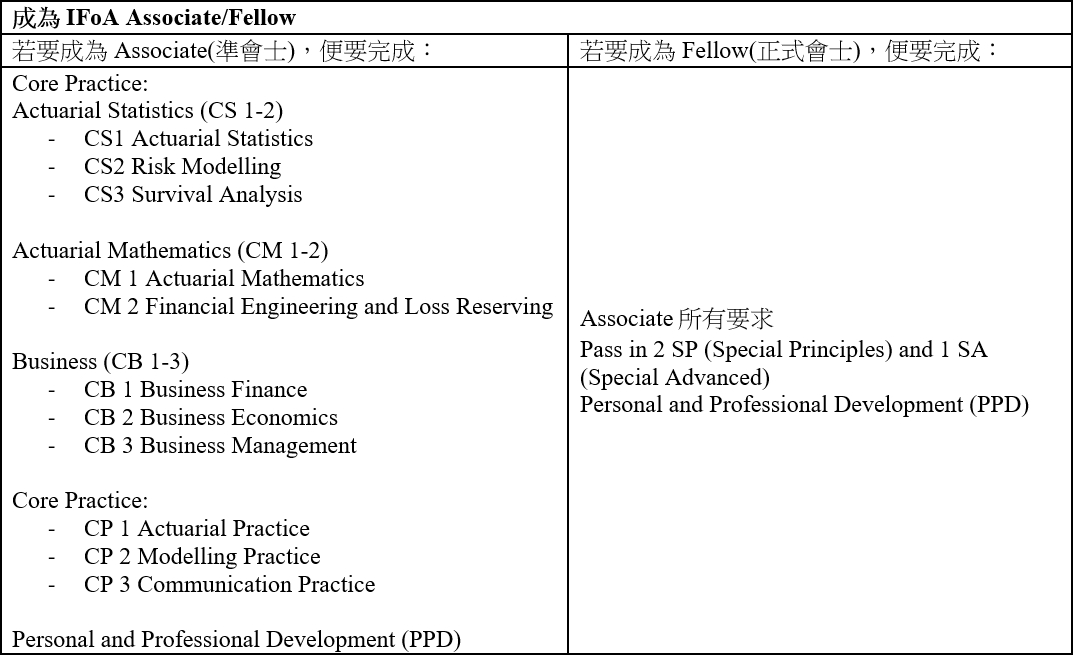
就業資料
香港大學的CEDARS提供不少有用的 就業資料(Internship, Jobs, Career planning, ...)
理學士課程:
以下為香港大學理學士課程學生的就業情況(聘請公司,待遇,職位等……)
Bachelor of Science 2019
Bachelor of Science 2018
Bachelor of Science 2017
Bachelor of Science 2016
Bachelor of Science 2015
Bachelor of Science 2014
(資料來源:CEDARS)
精算:
以下為香港的Actuarial Employers
LIST OF ACTUARIAL EMPLOYERS IN HONG KONG 2019
(資料來源:香港精算學會)
以下為香港大學精算學學生的就業情況(聘請公司,待遇,職位等……)
Bachelor of Science in Actuarial Science 2019
Bachelor of Science in Actuarial Science 2018
Bachelor of Science in Actuarial Science 2018
Bachelor of Science in Actuarial Science 2017
Bachelor of Science in Actuarial Science 2016
Bachelor of Science in Actuarial Science 2015
Bachelor of Science in Actuarial Science 2014
(資料來源:CEDARS)



